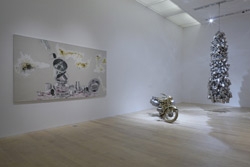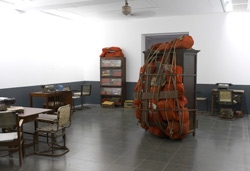Disarmingly pragmatic about the Indian art boom
Text: Chaitanya Sambrani
Portrait: Nawa Makiko
Widely hailed as the most prominent Indian artist of his generation on the international circuit, Subodh Gupta is a representative of the new Indian artist: ambitious, worldly-wise, constantly on the move between projects and exhibitions, forever sought after by galleries, curators and writers. For all this however, he remains disarmingly pragmatic about the implications of the global boom in contemporary Indian art for his own work, and that of his contemporaries.
 Installation view at Chalo! India: A New Era of Indian Art
Installation view at Chalo! India: A New Era of Indian ArtPhoto Watanabe Osamu
Courtesy Mori Art Museum
“Of course the growing interest in Indian contemporary art has affected me. It has given me the means to conceptualize and realize my work on a much larger scale than before. When you feel economically more secure, you are able to realize your work in a bigger way. You can think big. On the other hand, there is a lot of pressure along with this increased demand. It is sometimes not good for an artist to make art in a hurry. You can lose sight of the context.”
Gupta is not alone in being faced with the ironies of a rampant market that has created unprecedented opportunities for artists, while the institutional structure remains scanty, creating an endemic imbalance between abundance and scarcity.
“We now have many more galleries in India than we did five years ago. But there is still a lack of public infrastructure for contemporary art. Artists remain dependant on the commercial gallery system.”
Gupta is the classic internal migrant in India, describing a journey from a small town in Bihar to the dizzying pace of urban transformation in the boomtown of Gurgaon on the outskirts of Delhi. It is tempting to read into his traversal the romance of Hindi movies from the 1980s where making one’s fortune in the big city was always the dream of the small-town youngster. In terms of art institutions too, he has made the traverse from a provincial art school to a global audience.
The marks of passage are visible in a number of his works, which employ objects, materials and practices that have been ubiquitous in middle-class family life. But there are changes afoot it seems.

Date by Date, 2008
Mixed media installation
Courtesy the artist and Hauser & Wirth Zürich
© 2008 Subodh Gupta
Installation view at Indian Highway, Serpentine Gallery London
Photo Sylvain Deleu
“I have been working for many years with everyday objects, but I can feel a change in my practice. My inspiration is no longer based on my childhood or everyday life. The way I traverse territories – from home, to the city, and on to the world – has had an impact on the way my practice is evolving.”
His current position – as an Indian artist in an international art world that has recently ‘discovered’ India – comes with its own paradoxes, and Gupta is quick to point this out.
“When Jasper Johns made the American flag, he was an absolute American. If, as an Indian artist, I make a flag, I will be seen as both a nationalist and a boring artist. If you do not fit with the art language, you will not succeed as an artist, whether your work is inspired by the everyday, personal issues, political concerns, or even if your work is very conceptual.”
Originally printed in ART iT 22 Winter/Spring 2009

Subodh Gupta
Born 1964 in Khagaul, Bihar. Lives in Gurgaon (outside Delhi). Works across a range of media from sculpture, painting and photography to installation, video and performance. In 2009, he showed work at Indian Highway (Serpentine Gallery, London), Chalo! India (Mori Art Museum, Tokyo); and participated in the Tate Triennial.
